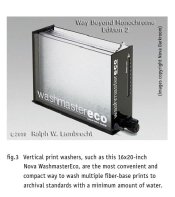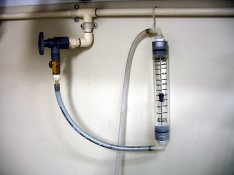I don't know if this works for everyone, but my Gravity Works print washer has an exit hose, running from the bottom, and an overflow at the top. It has a click pincher on the exit hose to control the speed of the exit flow. The first time I used it, I set the pincher at several different clicks, measured the exit with a container, as suggested, then calculated the time to completely fill (or exchange) the water in the tank, and selected a click setting on the pincher that gives me several (I think 6, it's been awhile) changes of water in 45 minutes. I just use the click setting for #3, and adjust the supply so that I have just a dribble overflowing. My temp control valve has an unmeasured flow control, so this is easy.









 option afterwards...
option afterwards...



